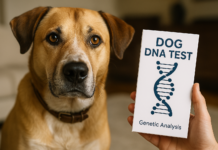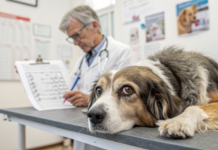Last Updated on October 11, 2022 by Dogs Vets
5 ingredients to look for in dog joint supplements
Many pet parents believe joint supplements are only necessary when their dogs start experiencing problems.
However, good joint care should begin from an early age, long before your dog has started showing the first signs of a joint disorder.
With so many products available on the market, dog joint health is an overwhelming topic.
So you might find it hard to decide what your dog actually needs.
As always, we encourage you to talk to your vet but if you decide to try some supplements on your own, here are the top five ingredients you should pay attention to.
Glucosamine
Glucosamine is an amino sugar that stimulates the growth of cartilage cells, so you understand how important this ingredient is.
Glucosamine has been used to help minimize inflammation and pain linked to arthritis and joint damage.

Some studies have discovered that once your dog reaches a sufficient level of glucosamine in its body, it will experience less pain and improve movement.
You could try Petz Park amazing dog joint supplements that contain plenty of glucosamine.
Chondroitin
Both glucosamine and chondroitin are commonly found in many joint supplements for dogs. Based on studies, they provide best results when given together.
Experts support the thesis that your dog’s body will absorb substances faster when glucosamine and chondroitin are taken in combination.
Many studies have confirmed that canines that took glucosamine and chondroitin managed to reduce inflammation, minimize pain, and slow down joint damage.
However, these two compounds were only effective when they reached therapeutic levels, meaning that the amount of supplements needs to reach and remain at a particular level in the canine’s blood.
If the compound fails to reach the desired level, your pet might not experience potential benefits.
CBD
CBD, also known as cannabidiol, is a substance extracted from a cannabis plant.
Dogs suffering from osteoarthritis may benefit from this compound because it can alleviate pain and improve movement.
On the other hand, some scientists are convinced that CBD has anti-inflammatory properties on the body and can help fight osteoarthritis and arthritis.
However, more research is necessary to determine the actual benefits for pups. Some early signs indicate that CBD may provide additional health benefits like:
- Minimize pain caused by nerve damage
- Control seizures
- Offer heart health benefits
- Reduce nausea
- Calm anxiety
Considering CBD is mostly focused on reducing pain, it gives a lot of hope to pet parents whose dogs have been diagnosed with osteoarthritis.
Omega-3 fatty acids
Inflammation is one of the reasons why many dogs feel the pain caused by osteoarthritis.
Omega-3 fatty acids are one of the components found in dog joint supplements that contain anti-inflammatory properties. They can also help with arthritis-related inflammation.
Additional benefits include:
- Healthy joint lubrication
- Better heart health
- Improved skin health
- Healthy kidney function
- Assist with cognitive challenges in older dogs
Nowadays, you can even find dog treats with omega-3 fatty acids.
Sometimes even dog food manufacturers supplement their kibble with omega-3 fatty acids. Krill and fish oil are the top sources of this compound.
Green-lipped mussel
GLM, or green-lipped mussel, is an ingredient found in many joint supplements. It contains various nutrients that support joint health, such as vitamins and minerals, antioxidants, amino acids, and omega-3 fatty acids.
Green-lipped mussel also has molecules that help lubricate cartilage, joints, and tendons. This ingredient comes in two forms.
Powdered GLM supplements are highly popular and many manufacturers produce powdered dog supplements that contain GLM.
You can easily add this to your dog’s canned food or kibble since most canines are attracted to the fishy odor. If your pet is skeptical, try mixing GLM with bone broth or frozen treats.
Sometimes you will find that GLM is already included in your dog’s food, so check the label just in case.
How to choose the best dog joint supplements?
Same as human vitamins and minerals, dog supplements aren’t regulated or tested for safety.
In fact, there is no way of knowing that a particular supplement will work 100%.
You will need to research on your own and know what ingredients to look for in joint supplements.
While many products will list glucosamine, chondroitin, and CBD oil, it doesn’t mean they contain enough of the substance to benefit your pet. Also, don’t assume that human supplements are safe for dogs. Many of them contain the sweetener xylitol, which is poisonous for pups.
Finally, only trust reputable companies that have been on the market for quite some time and have a proven track record.
Facts Check
We hope you enjoyed this article… What are your thoughts?
Please feel free to share this article!

















